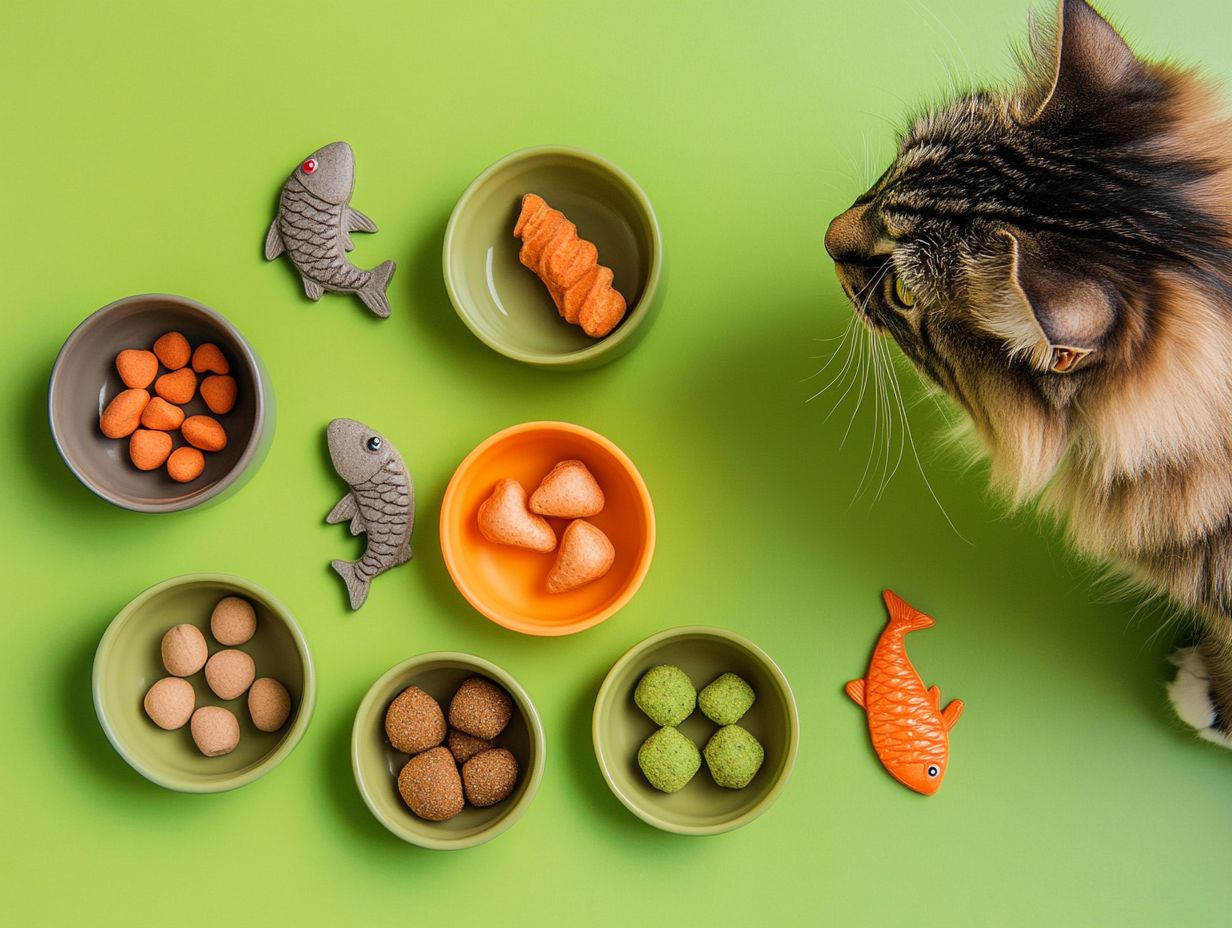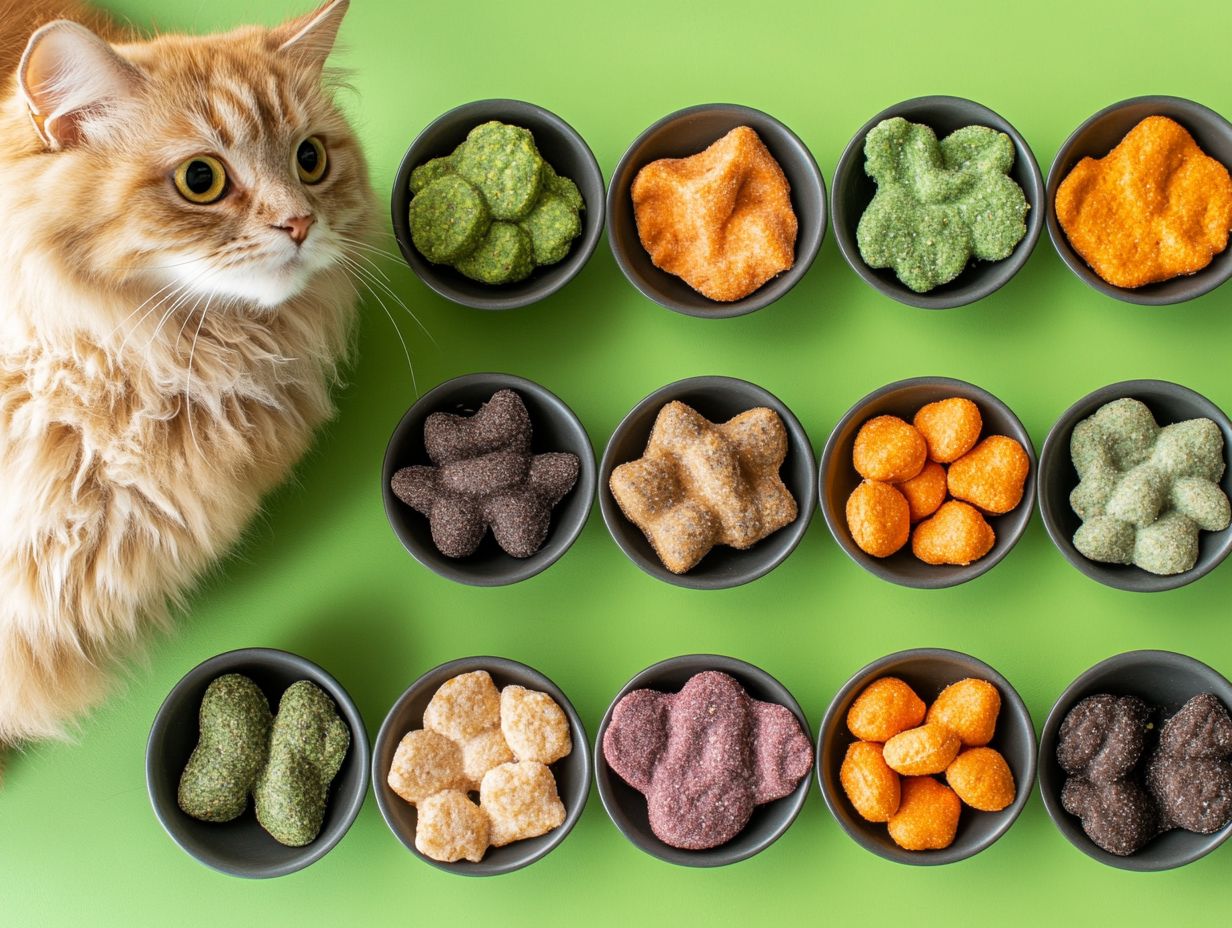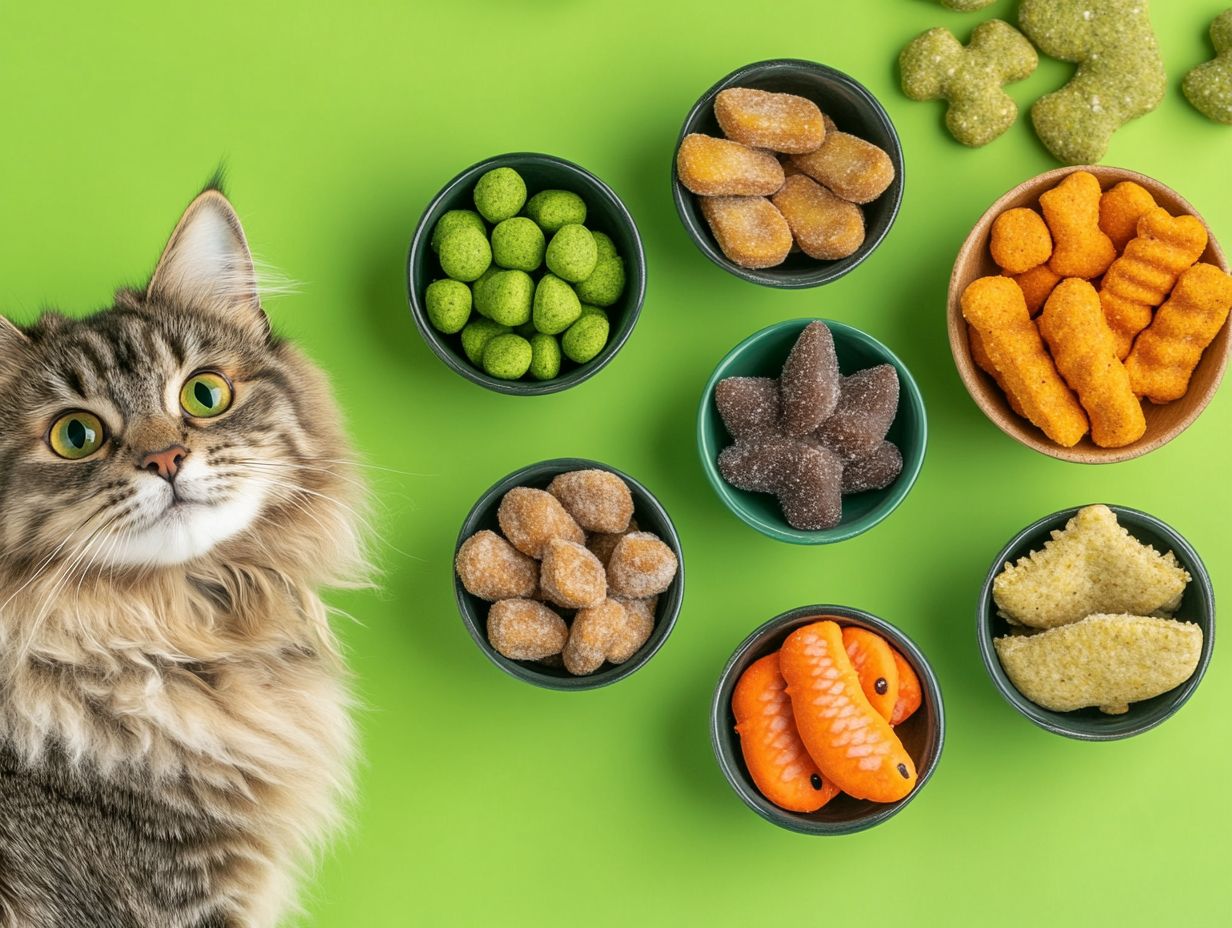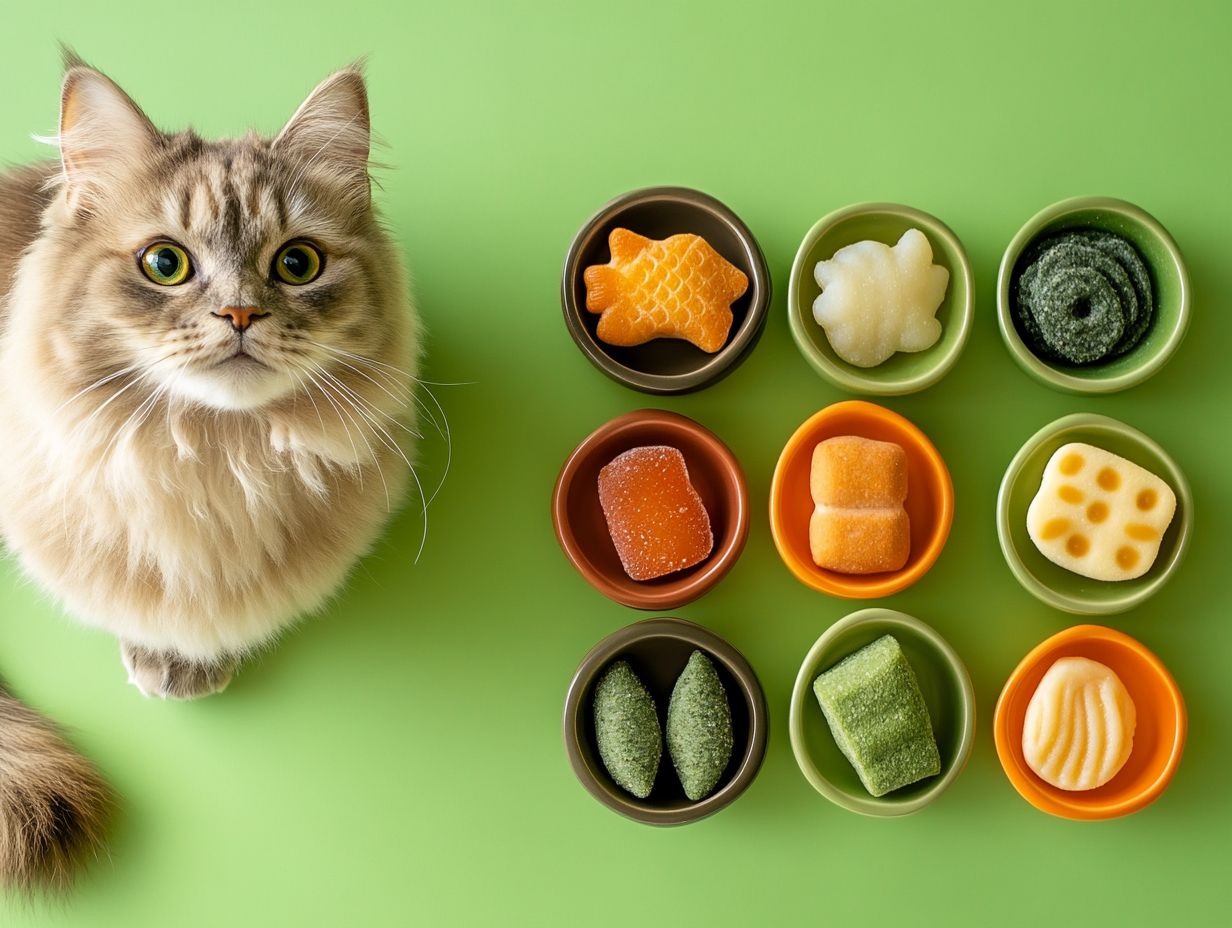Ensuring the health of our cats is a priority for any cat owner, and managing their weight plays a crucial role in their overall well-being. High-quality food, defined as nutrition that meets AAFCO or WSAVA standards, and proper feline nutrition are essential.
Overweight cats face numerous health risks, from diabetes to joint issues, making it essential to understand how to support their weight loss journey. It’s important to note that cats are obligate carnivores, meaning they require animal-source proteins for a balanced diet.
This article explores the impact of treats on your cat’s diet, highlights ingredients to avoid, and offers healthy snack alternatives that align with the nutritional needs of cats, emphasizing the importance of protein content. Additionally, we share practical tips to help your cat shed those extra pounds while still enjoying life.
Let’s get started!
Key Takeaways:

- Overweight cats are at risk for various health issues, making weight loss crucial for their well-being.
- Avoid treats with high calorie and filler ingredients like grains and by-products to aid in weight loss.
- Healthy cat treats, such as freeze-dried meat and fresh fruits and vegetables, should be limited and used as rewards or meal replacements to aid in weight loss. Always consult your veterinarian before making significant dietary changes.
Why is Weight Loss Important for Cats?
Weight loss is essential for cats, as it significantly enhances their overall health and decreases the risk of various weight-related issues, including diabetes, heart disease, and joint problems associated with pet obesity. The Association of Pet Obesity Prevention highlights the importance of maintaining a healthy weight.
According to the Association of Pet Obesity Prevention, maintaining a healthy weight is crucial not only for a longer lifespan but also for an improved quality of life in cats. Proper feline nutrition plays a vital role in this process; excess calories can lead to health complications.
Therefore, consulting veterinary nutritionists for individualized weight loss plans tailored to each pet’s specific needs is highly recommended. Veterinarians can also provide guidance on interpreting cat food labels to avoid harmful ingredients.
What Are the Risks of Overweight Cats?
Overweight cats face a range of health problems that can significantly diminish their quality of life and shorten their lifespan. These issues include diabetes, heart disease, and joint problems, which can manifest as mobility issues and pain. Veterinary medicine continues to emphasize prevention and management of these conditions.
What Health Problems Can Overweight Cats Develop?
Overweight cats are at risk of developing a variety of serious health problems, including diabetes, liver disease, and joint issues, which can significantly impair their mobility and overall well-being.
These health complications can lead to a decreased quality of life, as affected cats may exhibit symptoms such as lethargy, difficulty in movement, and excessive thirst.
For instance, diabetes is characterized by excessive urination, increased appetite, and weight loss despite a good diet, while liver disease may manifest as vomiting, jaundice, and a reluctance to eat. Treatment typically involves dietary changes, increased physical activity, and, in some cases, medications.
Prevention is crucial and can include regular veterinary check-ups, portion control in feeding, and encouraging playtime. Studies indicate that effective weight management not only reduces these risks but can also help reverse some conditions.
Veterinary professionals emphasize the importance of maintaining a healthy weight to ensure a longer, healthier life for cats.
How Can Cat Treats Affect Weight Loss?
The impact of cat treats on weight loss depends on their calorie content and the ingredients used. Therefore, moderation is essential when incorporating treats into a healthy diet for your cat.
What Are the Ingredients to Avoid in Cat Treats?
When selecting cat treats, it is crucial to choose options that do not contain harmful ingredients or excessive calories, such as artificial additives and toxic foods like onions and chocolate. These ingredients can be categorized into harmful additives and potential allergens, which can contribute to future health issues, including obesity and diabetes.
It’s also important to read cat food labels carefully. Look for ingredients that are high in animal protein and avoid those with excessive fillers or vague terms like ‘meat by-products’.
Additionally, handling and storing cat treats properly is vital to prevent spoilage. Store them in a cool, dry place and ensure the packaging is sealed to maintain freshness.
Lastly, remember that senior cats or those with pre-existing conditions, such as kidney disease, may have specific dietary needs that should be considered during weight management.
For instance, artificial flavors and preservatives may lead to food sensitivities, while high sugar content can result in rapid weight gain. Ingredients like corn syrup and by-products offer little nutritional value and primarily consist of low nutritional value, which can lead to further health complications. Cat food labels should be checked for these unhealthy ingredients.
Instead, it is advisable to opt for cat treats made from high-quality natural ingredients, such as chicken, fish, or pumpkin. These options satisfy cravings without compromising health and support a balanced diet. Blue Buffalo and Greenies are some brands offering these treats; ensure they comply with AAFCO standards to ensure quality and safety.
What Are Some Healthy Cat Treat Options for Weight Loss?

The healthiest cat treats for weight loss include freeze-dried meat treats, fresh fruits and vegetables, and organic options. These treats provide essential nutrients while keeping calorie intake low. Moderation is key when integrating these into a cat’s diet.
1. Freeze-dried Meat Treats
Veterinarian-recommended freeze-dried meat treats are among the best options for cat snacks, as they are high in protein, low in calories, and typically made with few natural ingredients. These quality snacks provide essential nutrients and help cats maintain their ideal weight when included in a balanced diet, ensuring they receive the necessary daily protein without excess calories.
Many leading cat treat brands, such as Blue Buffalo, offer freeze-dried options that are recommended by veterinarians due to their high nutritional value. Additionally, these treats serve as effective training rewards for positive reinforcement, contributing to a cat’s overall health and vitality. When choosing these treats, make sure they come from reputable brands that comply with AAFCO standards.
Whether sprinkled on regular food or given separately, these convenient treats can easily be incorporated into any cat care routine.
2. Fresh Fruits and Vegetables
Fresh fruits and vegetables can be low-calorie, nutritious treats for cats, offering essential vitamins and minerals while helping to manage calorie intake. Options such as cucumbers, blueberries, and small pieces of cooked carrots can provide hydration and support digestive health. However, not all fruits and vegetables are safe for cats; always consult a veterinarian before introducing new foods.
These snacks are an excellent way to introduce new flavors and textures into a feline’s diet. It’s important to prepare them properly by washing them thoroughly and cutting them into bite-sized pieces to prevent choking hazards. Serving these treats in moderation helps maintain a balanced diet, ensuring that the cat doesn’t overeat or experience gastrointestinal discomfort.
Additionally, always monitor for any allergic reactions when introducing new treats, as some cats may be sensitive to certain foods. Common allergens include dairy, fish, and wheat. Consulting with a veterinary nutritionist like Susan G. Wynn, DVM, can provide further insights.
3. Homemade Treats
Homemade treats enable cat owners to control the ingredients, ensuring that only healthy, organic options are used. This makes them an ideal choice for weight management.
These nutritious snacks can be tailored to meet specific feline tastes and dietary requirements, providing a fun and positive way to engage in pet health. By incorporating healthy, natural ingredients, including organic treats, owners can enhance their cats’ diets with vitamins and minerals that promote overall well-being.
Examples of satisfying treat recipes include:
- Salmon and sweet potato biscuits
- Chicken and pumpkin bites
- Chicken and pea puffs
To create a comprehensive wellness plan for their cats, pet owners should consult with a veterinarian to ensure that any new treats align with their pet’s unique health and nutritional needs. Homemade recipes should also be discussed with a veterinarian to avoid potential nutritional imbalances or deficiencies, especially for cats with special dietary needs.
How Can You Limit Treats for Weight Loss?
Limiting treats is crucial for effective weight loss in cats, and pet owners can employ several strategies to achieve this, such as using treat tips and measuring out portions. Follow portion size guidelines based on a cat’s weight and dietary needs, consistent with current feline obesity guidelines.
1. Use Treats as a Reward, Not a Regular Snack
Using treats as occasional rewards instead of regular meals can significantly help control a cat’s calorie intake while also allowing for positive reinforcement of desirable behaviors. This approach keeps the cat engaged during training sessions and fosters a healthy relationship with food. Lickable treats like Frisco Natural Cat Grass can be ideal for such purposes.
Rewarding at strategically different times enables owners to reinforce good behavior without exceeding daily caloric needs for their pets. Opting for treats that meet AAFCO standards for feline treats can assist owners in aligning their feline’s reward system with weight loss goals.
Achieving this balance can lead to improved behavioral outcomes and enhanced physical health, ultimately resulting in a more vibrant and energetic pet.
2. Measure Out Treat Portions

Measuring out treat portions ensures that cats receive only what they need for training or rewards, helping to keep their overall calorie intake in check during their weight loss journey. Treats should constitute no more than 10% of a cat’s daily caloric intake.
By using a small measuring cup or a kitchen scale, owners can accurately determine the appropriate amount of treats to give, preventing exceeding daily caloric needs. Vet recommendations often include such precision to manage weight problems.
Additionally, maintaining a daily log of both food and treats is beneficial; recording each item consumed allows for easy tracking of caloric intake. This practice not only promotes accountability but also provides insights into eating patterns, making it easier to adjust portions as needed.
Keeping this data can significantly aid in strategizing weight loss goals, ensuring that pets stay on track for healthier living.
3. Use Treats as a Meal Replacement
In some instances, treats can serve as meal replacements for cats struggling with their weight, provided they are nutritionally balanced treats formulated for weight management and suitable for a cat’s metabolism. When a cat refuses its usual food—possibly due to dietary changes or illness—using specially formulated treats, such as lickable treats or those made with natural ingredients, can help ensure that its nutritional needs are still being met. Note that treats should not entirely replace a complete diet, as this could lead to nutritional deficiencies.
Cat owners can select treats that offer the necessary protein, vitamins, and minerals essential for a cat’s overall well-being. It is important to consult veterinary nutritionists, such as those certified by the Association of Pet Obesity Prevention, to confirm that the treats align with a cat’s specific nutritional requirements for effective weight management. This precaution will help avoid potential health issues.
What Are Some Other Tips for Helping Your Cat Lose Weight?
Along with managing treat intake, other tips to help cats lose weight include:
Refer to pet obesity resources for comprehensive guides on maintaining your cat’s health.
- increasing exercise
- monitoring food consumption
- consulting a veterinary nutritionist for personalized advice, especially for any specific health conditions (e.g., kidney disease, diabetes)
- Using high-quality foods and treats, such as those from Purina Pro Plan, for balanced nutrition.
1. Increase Exercise and Playtime
Increasing your cat’s exercise and playtime is essential for weight loss, as consistent physical activity is necessary for burning calories and maintaining a healthy lifestyle. Cat guardians can enhance their pets’ health and wellness by incorporating a variety of methods into their exercise routine, including the use of high-quality food for energy.
Games that involve movement, such as feather wands or laser pointers, engage a cat’s natural predatory instincts, providing entertainment through exhilarating chases. Setting specific times during the day for play can help establish a routine and ensure that physical activity becomes a regular part of their schedule.
Making exercise enjoyable—such as creating obstacle courses with books, boxes, or other household items, or using puzzle feeders to stimulate their minds—encourages cats to exercise regularly. Care should be taken to avoid overexerting senior cats or those with health issues, and veterinary advice should be sought to ensure safety. Ensuring that playtime is mentally and physically rewarding will help make it a consistent aspect of their daily lives, thereby supporting weight loss efforts.
2. Monitor Food Intake
Monitoring food intake is essential for weight loss, as it enables cat owners to track the calories their pets consume and adjust their diets accordingly. Refer to cat food labels to better understand caloric content and nutritional benefits.
Practical methods, such as using measuring cups and maintaining a food diary, allow pet owners to closely monitor their cat’s food intake. Measuring portion sizes is important to prevent overfeeding, while a food diary provides a daily overview of how much the cat is eating. These methods facilitate adjustments based on the cat’s weight loss progress. It’s also crucial to consider a cat’s life stage (kitten, adult, senior) in evaluating dietary needs and caloric intake.
Additionally, owners should be cautious and avoid using treats that contain harmful ingredients or allergens to ensure the safety of their pets.
Disclaimer: Cat owners should consult with their veterinarian before making any significant dietary changes for their cats.
If the desired weight loss results are not being achieved, portion sizes can be reduced gradually to promote healthier weight loss, always ensuring that proper nutrition is maintained for the cat to avoid nutritional deficiencies.
3. Consult with a Veterinarian
Consulting with a veterinarian or veterinary nutritionist is a vital step in ensuring your cat loses weight safely. These professionals can provide tailored advice and ongoing monitoring for your pet’s health. Notable veterinary experts like Marla J. McGeorge, DVM, and Susan G. Wynn can offer specialized guidance. Their expertise is especially valuable for cats with special dietary needs due to health conditions, such as kidney disease or diabetes.
Regular check-ups are essential, as they enable the veterinarian to track progress, adjust the diet or exercise regimen as needed, and ensure that weight loss occurs at a safe and sustainable rate. It’s crucial to remember that some cats may have specific dietary restrictions where professional guidance is vital.
This professional oversight not only aids in achieving desired results but also promotes overall well-being, allowing your feline companion to lead a healthier and more active life.
Frequently Asked Questions

Can I give my cat treats while they are on a weight loss diet?
Yes, you can give your cat treats while they are on a weight loss diet as long as they are healthy and low in calories. However, ensure their nutritional content aligns with AAFCO standards to ensure they are beneficial during weight loss. Moderation is key to ensuring treats do not interfere with their weight loss goals.
What are some healthy cat treats that won’t sabotage my cat’s weight loss diet?
Some healthy cat treats for weight loss include freeze-dried chicken, small pieces of cooked fish, and low-calorie catnip treats. Brands like Blue Buffalo and Wellness Kittles offer healthy options. However, remember that catnip should not be the mainstay of a weight loss plan, as treats should primarily be protein-based.
How often should I give my cat treats while they are on a weight loss diet?
For further guidance, refer to resources from the Association of Pet Obesity Prevention and WebMD. It is recommended to give your cat treats in moderation, no more than 10% of their daily caloric intake. This can be around 1-2 treats per day depending on the type of treat and your cat’s weight loss goals. Always choose treats with healthy ingredients and avoid those with high levels of carbohydrates or artificial fillers.
Are there any ingredients I should avoid in cat treats for weight loss?
Additionally, avoid toxic foods such as onions, garlic, and chocolate, which are harmful to cats. Avoid treats with high levels of carbohydrates, fillers, and artificial ingredients, as these can lead to weight gain and health issues for your cat. Always check with your veterinarian for vet recommendations on suitable treats.
Can homemade treats be a good option for my cat’s weight loss diet?
Yes, homemade treats can be a great option as you have control over the ingredients and can make them low in calories and healthy for your cat. Organic treats made from natural ingredients can be particularly beneficial. However, check with your veterinarian before introducing any new treats, especially homemade ones, to ensure they meet your cat’s specific dietary needs.
How can I help my cat stay on track with their weight loss diet while still giving them treats?
One way to help your cat stay on track is to use their regular kibble as treats throughout the day. This way, they are still getting a reward without consuming additional calories. Consider using approved brands like Hill’s Metabolic or Royal Canin for structured weight management. Additionally, monitor calorie intake closely, possibly by maintaining a food diary, to assist in tracking progress effectively.
How can I ensure the safety of homemade treats for my cat?
When making homemade treats, recognize signs of spoilage, such as unusual odors or changes in texture, to promote safe feeding practices. Also, consider the ethical implications of sourcing ingredients for homemade treats while prioritizing your cat’s health and safety.